
Draggable ScaleBar in ArcGIS API for JavaScript
Scale it up
There are some standard things you might find on a web map. A legend, some form of navigation tools, attribution, and yes… a scalebar. I’ll admit, I usually think of a scalebar as something I would only want on a printed map, but it does help provide some contexts in your webmaps as well. The scalebar is interesting in an interactive map because as you navigate the map without changing the scale, it can change, depending on the spatial reference you are using, typically as you navigate north and south. So it ocurred to me, what if I could just drag the scalebar around my map and get some quick measurements. I mean you have the measurement widget, but you do you boo.
Writing a Custom Element
If I’m going to do something with some custom behavior, you better believe I’m going to make a custom element. The custom element is going to allow me to wrap content in a container that will allow me to drag it around the page. Moving an element across a page require some work listening to DOM events, not just on my own custom element, but the window in general.
The first thing I want to do is create an anchor that I can use to drag the container around. I can add this to the shadowRoot of my custom element.
const template = document.createElement("template");
template.innerHTML = `
<div class="drag-container-template">
<slot></slot>
<span class="drag-container__btn">
<svg/></svg>
</span>
</div>`;
this.shadowRoot.appendChild(style);
this.shadowRoot.appendChild(template.content.cloneNode(true));Next I need to start binding some events. I need to listen to a mousedown
event on the anchor to kick off the work I need to do to drag the element around
the page. Then I need to listen for window events to know where I am dragging
the mouse, and can move the element to.
connectedCallback() {
const button = this.shadowRoot.querySelector(".drag-container__btn");
button.addEventListener("mousedown", this._onMouseDown.bind(this));
window.addEventListener("mouseup", this._onMouseUp.bind(this));
window.addEventListener("mousemove", this._onMouseMove.bind(this));
}
_onMouseDown() {
this.mouseDown = true;
}
_onMouseUp() {
this.mouseDown = false;
}
_onMouseMove(event) {
if (this.mouseDown) {
this.style.top = event.clientY - this.clientHeight + 10 + "px";
this.style.left = event.clientX - this.clientWidth + 10 + "px";
this.dispatchEvent(new CustomEvent("dragging"));
}
}You can see in this snippet here, I am managing some state here by toggling a
boolean mouseDown property on my element. Then depending on where the mouse is
on the mousemove event, I can update the style.top and style.left values
of the element to move it around the page. I know my anchor icon is 20px in
height and width, so I use an offset of 10px when I calculate it, so that my
cursor is in the middle of the anchor and not in the corner. This adds just a
little bit better of a user experience.
Here is the whole custom element.
class DragContainer extends HTMLElement {
constructor() {
super();
this.mouseDown = false;
this.attachShadow({ mode: "open" });
const style = document.createElement("style");
style.textContent = `
:host {
width: max-content;
}
.drag-container-template {
display: flex;
align-items: center;
}
.drag-container__icon:hover {
cursor: pointer;
filter:
invert(0.5)
saturate(6)
brightness(1);
}
`;
const template = document.createElement("template");
template.innerHTML = `
<div class="drag-container-template">
<slot></slot>
<span class="drag-container__btn">
<svg xmlns="http://www.w3.org/2000/svg" class="drag-container__icon" width="20px" height="20px" viewBox="0 0 32 32"><path d="M16.5 29.8A13.3 13.3 0 1 0 3.2 16.5a13.3 13.3 0 0 0 13.3 13.3zm0-25.6A12.3 12.3 0 1 1 4.2 16.5 12.3 12.3 0 0 1 16.5 4.2zm0 20.6a8.3 8.3 0 1 1 8.3-8.3 8.309 8.309 0 0 1-8.3 8.3z"/><path fill="none" d="M0 0h32v32H0z"/></svg>
</span>
</div>`;
this.shadowRoot.appendChild(style);
this.shadowRoot.appendChild(template.content.cloneNode(true));
}
connectedCallback() {
const button = this.shadowRoot.querySelector(".drag-container__btn");
button.addEventListener("mousedown", this._onMouseDown.bind(this));
window.addEventListener("mouseup", this._onMouseUp.bind(this));
window.addEventListener("mousemove", this._onMouseMove.bind(this));
}
disconnectedCallback() {
const button = this.shadowRoot.querySelector(".drag-container__btn");
button.removeEventListener("mousedown", this._onMouseDown.bind(this));
window.removeEventListener("mouseup", this._onMouseUp.bind(this));
window.removeEventListener("mousemove", this._onMouseMove.bind(this));
}
_onMouseDown() {
this.mouseDown = true;
}
_onMouseUp() {
this.mouseDown = false;
}
_onMouseMove(event) {
if (this.mouseDown) {
this.style.top = event.clientY - this.clientHeight + 10 + "px";
this.style.left = event.clientX - this.clientWidth + 10 + "px";
this.dispatchEvent(new CustomEvent("dragging"));
}
}
}
customElements.define("drag-container", DragContainer);Using the Custom Element
The beauty of custom elements is that they should be simple to use. I should be able to just add it to the page, treat it like any other native DOM element, and maybe listen to some events and interact with it. Not to say custom elements can’t be more complex, but from a user standpoint, I like simple.
<div id="viewDiv">
<drag-container>
<div id="scalebar-container"></div>
</drag-container>
</div>const map = new ArcGISMap({
basemap: "gray-vector",
});
const view = new MapView({
container: "viewDiv",
map,
zoom: 1,
});
view.when(() => {
const scalebar = new ScaleBar({
view,
container: "scalebar-container",
});
// reference to custom element
const drag = document.querySelector("drag-container");
drag.addEventListener("dragging", () => {
scalebar.renderNow();
});
view.ui.add(drag, "manual");
});There’s a little css sprinkled in here as well, but these are the key bits. At this point, I can start dragging my scalebar around the map and you can watch it change as it scurries around the map. You can view it in action here.
Summary
I know this blog post is about dragging the scalebar around the map, but it was secretly about creating a draggable custom element. Gotcha! You can use this custom element with anything, doesn’t even need to be a widget, but the idea really did spring up from, I want to drag the scalebar around the map and it fits, because you can see the impact it has right away. This was a fun experiment in building a custom element, and I hope it inspires you to give custom elements a try.
You can watch a video on this topic below!